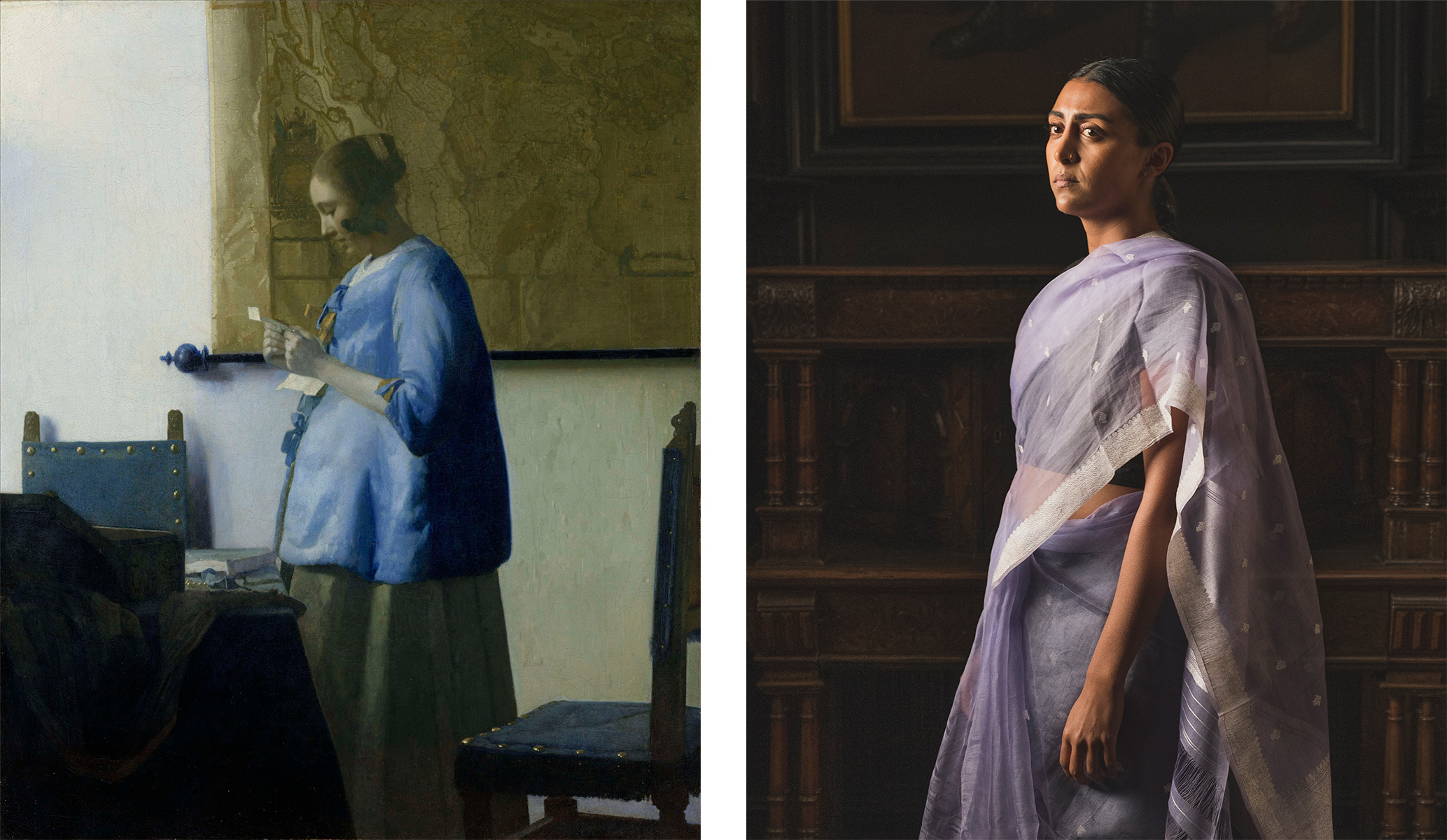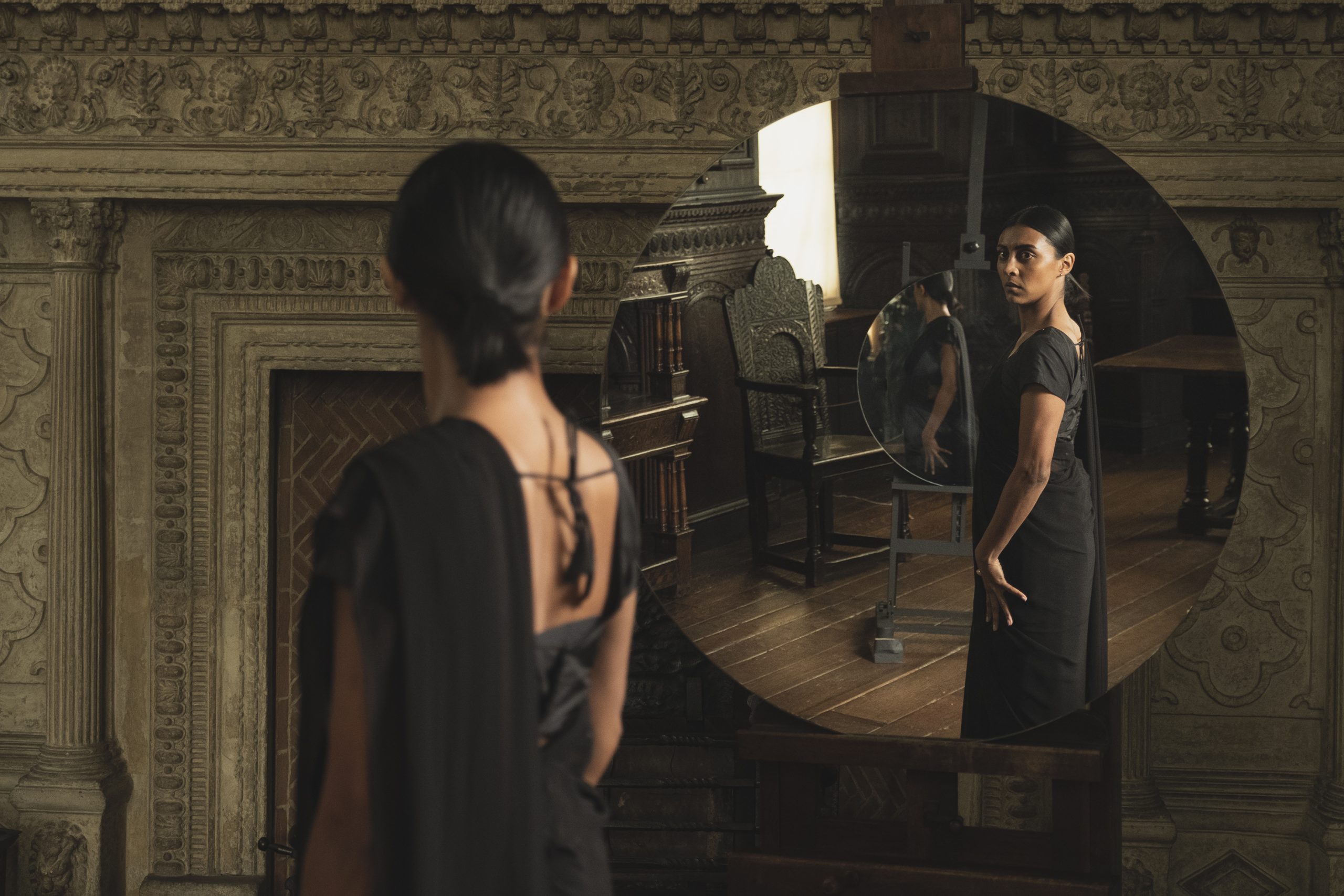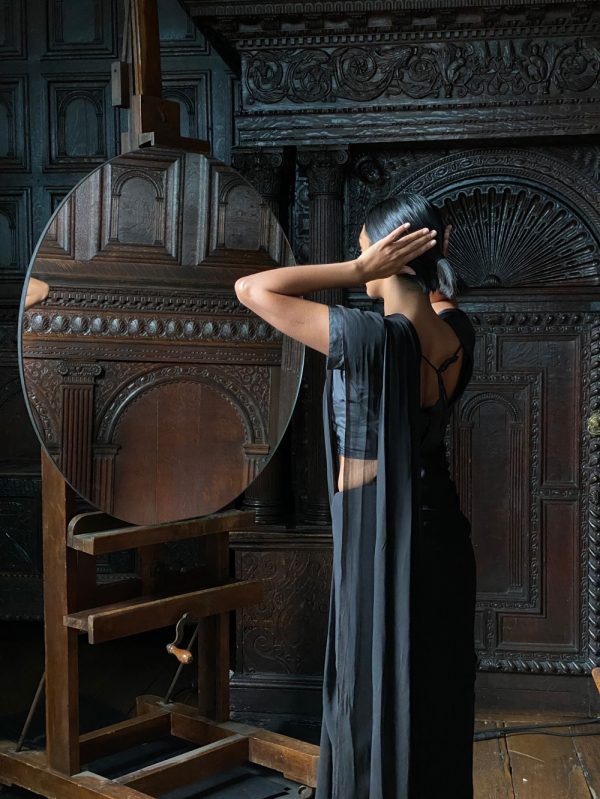Sutapa Biswas
A Space Between Homes
We all have a favourite childhood memory, the story we only tell when we want to remember a priceless moment; or an embarrassing tale we want everyone to forget yet will always come up in family gatherings. The stories of our past are an accumulation of how we see the present world today. But what happens when the memories we hold are the brutal consequences of a colonial aftermath that we didn’t ask for; our experiences are no longer just ours to keep and become a collective account for the generations to come. In Lumen, Sutapa Biswas takes on the inherent duty to narrate, share and acknowledge those stories as a forgotten page for the history books.
Sutapa Biswas is an interdisciplinary artist who has worked with mediums such as painting, drawing, film, photography and installation during her extensive career. Lumen comes as a pivotal point in Biswas’ artistic journey by marrying in many of the themes that recur within her practice.
Biswas was born in India and moved to England with her family in 1966 following her father’s dissent against the Indian government. Studying in England, she has continued to pursue an interest in themes surrounding colonial histories, particularly with regard to gender, race and class. Biswas played a vital role within the Black Arts Movement, ensuring her voice could be heard and challenging the lack of previously marginalised voices in the art world. In Lumen, she continues to question and rewrite dominant western narratives.
Sutapa Biswas, Lumen, Film Still, 2021.
Lumen is a 30 minute long film, which combines the stories of herself, her mother and grandmother, through references to their voyage by sea to England. Actress Natasha Patel plays the narrator and is an embodiment of all three characters. Shot in locations between the West Coast of India and at the Red Lodge Museum in Bristol, Lumen also features footage filmed during the British Raj in India from Bristol Films Archive and imagery relating to the British East India Company created by James Forbes, sourced from the Yale Centre for British Art. The film in itself is situated between making a commentary about the past, more specifically British colonial rule, The Dutch East India Company and later moving onto the post- independence moment in India. Described as the measure of light to the human eye, the world “Lumen” also refers to structures in the body such as an artery. This film piece connects these two meanings in showing what is visible to the naked eye but also what comes to light from bodily trauma. (Biswas 2021, 100). In Lumen, we move through time and space to reveal stories of migration, referencing nostalgic scenes of India’s past and the brutal history of British rule.
The monologue can be described as a poetic journey, like the ocean, depicting real sentiments of displacement.
The film takes the form of a monologue where the central narrator speaks directly to the camera. This semi-fictional narrative begins with a baby emerging from the womb and ends with a note of departure. The central voice carrying this story through is her mother, providing a female-driven narrative as opposed to the stories and histories that have historically been told from a male perspective. The narrative is poetic and evokes ideas of displacement. During the journey by boat, her mother travels further away both physically and metaphorically from the land that was her home to a country that was the cause of discomfort, brutality and hardship.
In art history, we see stories told through a male perspective. bell hooks comments on the oppositional gaze as a way of claiming the agency that allows black people to resist against the repression of how they are perceived by the white gaze in cinema (hooks 1992, 117). Not only underrepresented, the black woman is not allowed to look. Biswas here echoes these ideals with the way she takes ownership and disrupts the power dynamics. She asserts this view in making a work presented by a female, written by a woman and told through the female lens.
The creation of the monologue follows a rhythm that Biswas describes in places as Shakespearean (Biswas 2021, 99). Shakespeare becomes an important reference as Biswas’s parents and grandparents were educated in English under British rule and were taught about Shakespeare amongst many British poets. During this time they were also forbidden to speak in their own mother tongue. The power of sound becomes a prevalent aspect of the production and how it is read in the space, echoing on from Tina M Campt’s ‘The Black Gaze’ which reiterates this idea of how, for the black woman, only using words is not adequate to render the complexity of their interiority (Campt 2021, 153). Here we see Biswas using sound as a commentary when words are not enough. The sound doesn’t let the film become a passive act of watching, but rather a witness of the haunting accounts it is recalling. The sound does not let you leave, it does not let your mind wander away from the screen.
The scenes throughout the film are meticulously constructed to not only tell her mother’s story but also draw on source material that influenced the creation of this work. Biswas reflects on the painting Woman in Blue Reading by Johannes Vermeer. Here Vermeer has represented a woman in her own private world engaged in a moment to herself. She is seen intently reading a letter, unaware that she is being watched. It depicts a very personal moment, even without knowing the contents of the letter, making the viewer intrigued about what it is she may be reading.
Left: Vermeer, Johannes, Woman reading a letter, c. 1662-1663. Right: Supta Biswas, Lumen, Production Still – Woman in Blue. 2021
References to this image are both visually and metaphorically referenced in this film still from Lumen. Here we see the actress, draped in a blue saree that belongs to Biswas’s mother, looking away into the unknown. This saree is amongst the few belongings her mother brought with her from India and carries the stories of a life before. Although there isn’t a letter in her hand, the scene before it makes reference to the ‘chiti’ (letter) that has come, but she refuses to open it. For the pain is too much to bear in reading about a land she cannot go back to. Memories evoked from the paraphernalia of the past, in this case the letter, triggers this involuntary emotion and recollection which Biswas has not been able to let go of. (Tawadros 1993, 47). Working as an anchor of that specific moment, the familiarity in the image, shows both women dressed in blue unaware of their surroundings. For Biswas, the painting reminds her of her mother weeping when reading letters from home. These critical elements allow the viewer to gain an understanding of a fraction of the emotions the character may be experiencing.
Sutapa Biswas, Lumen, Production Still. 2021.
The majority of the scenes show the main character asserting her direct gaze at the viewer when reciting the lines of the monologue. This particular scene shows her looking through the mirror, back at the viewer. The position of the mirror in this scene allows us to view her three times and works as a symbolic reference of Biswas, her mother and her grandmother all present in the same space, sharing this moment in time.
Mirrors are used throughout the film to depict more than one person present at the same time. Often the character is found talking in front of the mirror. Mirrors are sometimes used as a symbol of vanity, and when a woman is placed in front of one, she can be perceived as self-conceited and egotistic. Here however, we witness habitually performed intimate acts such as fixing her untucked hair or her saree pleats. This particular mirror in this film still is resting upon an artist’s easel, out of place within the stately home, with its Dutch- style interior. A space for traversing time and dimension in that it evokes the past, the present, and future. The easel could act as a metaphor of how Biswas’s mother felt arriving in a place so far away from home, and not fitting into it. In some ways it also acts as the artist looking at these intimate acts of privacy, and allowing us to witness, along with her, her mother’s state of grief. She had to carry this mirror which becomes a façade for the world; the left-over paint becomes a symbol of the traces left behind from a life no longer known.
The film is shot partly in Bristol Red Lodge which visually resembles the Dutch interior of Vermeer’s painting and also references the Dutch East India Company. From the oak furnishings to the essence of a British stately home, all work to evoke recollections of Britain’s colonial past. It also makes use of original footage shot in India alongside archival images of the British Raj. Home movies present the privileged lives of the British with natives from India in service to them. This footage provides a universal context for the personal narrative to unfold.
Throughout the film, we see the main character dressed in a plain simple black saree. In India, wearing black can connote sadness, anger and darkness which may reference the absence of joy (Rajakaruna 1993). Black is never to be worn at celebrations and is often used to represent evil spirits. The significant choice to wear this black saree throughout the film brings together all these indicators, whilst the simplicity in her outfit also further highlights everything that is left behind.
Leela Gandhi discusses the need for postcolonial discussion and the tendency to refuse to accept the impact of a colonial aftermath (Gandhi 2019, 4). Gandhi addresses the resistance to the mystifying amnesia that colonial history brings, and in order to accept and acknowledge we must look back at the whole recollection of what post-colonial oppression was and its relationship to power. Using imagery that is evident of a time that is long forgotten and, in many cases, erased from British history, what Biswas is doing here with Lumen is not only acknowledging this history but is calling to our attention the ways in which British and Indian histories are intertwined.
Biswas also draws on drawings and paintings by James Forbes sourced from the Yale Centre of British Art. James Forbes travelled from England to India in the 1700s when the British East India Company was established, depicting his observations of Indian subjects including wildlife, flora and fauna. His approach documented the India that Britain wanted to see. Biswas mentions the link between the journey Forbes took as in the opposite direction to her mother and family so many hundred years prior through the same ocean that separated the countries. Although this work does not connect to Forbes as an individual, it still conveys this connection between both himself and her mother many years apart. Biswas draws attention to the two contrasting journeys, taken in different times and for different reasons, and pursuing different directions.
Biswas uses this element as a way of conversing with her own identity which is not always transparent. Resonating from Stuart Hall’s text ‘Cultural Identity and Diaspora’, identity should be seen as a production of components and never complete as one or whole. For Biswas, the past is an important and integral aspect of who she is and this resonates within work she is creating. There is an element within the monologue that struck me the most, and this is where the character becomes confrontational. She is aggressive and she is angry. Here we also see the power of sound where it ascends to accompany her distress and declines rapidly to allow that moment of reflection and convey her emotions when words fall short. It’s important to understand that there are many memories of this history that are hurtful and wounding, which the character shows in the way she speaks, addressing the British. Through this, we are able to see the pain these memories may have caused Biswas’s mother and later Biswas herself.
Another striking film still is an image of the character laying on the ground surrounded by fallen apples. Apples are associated with many forms of symbolism and ideologies, from religious iconography to mythical components. The forbidden fruit surrounds the character as she lays staring away from the camera. Amongst the apples, we see two pomegranates placed on either side of the body. Pomegranates have lifelong connotations to fertility and prosperity in Hinduism, while also symbolising everlasting life in Christian art and imagery (Spry 2019). Ripe, uncut fruits on the ground, work as a moment of reflection intermittently within the film. Taking reference to James Forbes’s cataloguing of Indian subjects, the scene acts as a contemplation of land that is far away, with fruits that can’t be touched or held, an allegory back to her mother in a faraway land.
Looking at Lumen, I am reminded of a video performance piece created by Biswas called ‘Kali’ in 1984 whilst still a student. It looks at the Hindu goddess Kali, whose name literally translates as black goddess. Within Hindu mythology she is depicted as having more than one representation which is shown in the video piece through the many identities portrayed (Tate n.d). Each character aims to rid the world of evil, who is embodied by Ravan, played by Isabelle Tracey. Kali, in many ways performs a very similar act of bringing in Hindu mythology and iconography to an audience who is otherwise unaware, or to some extent ignorant, of other cultural systems. (Bentcheva 2014, 9). Kali becomes a recurring subject in Biswas’s earlier works and as a means of exploring issues of race, gender, class and subjectivity. Like Lumen, there is a soundtrack including written text by Biswas which is spoken in Bengali, her mother tongue. There is an evident shift in the production methods between both video pieces which are due to various factors such as technological advancements to the way Biswas’s own visual strategies have developed. Biswas draws the viewer in, inviting you to want to know more.
Much of Biswas’ practice deals with tracing elements of her own cultural history and reworking those ideas to reveal and challenge ideas of a colonial past. (Bentcheva and Biswas 2014). If Kali was a painful raw moment of reflection, Lumen evokes anger from holding in these emotions for decades. From understanding and fighting the evils around us, to dealing with the inner wounds left over years of displacement witnessed at home, Lumen brings together this sense of the everyday in connecting to the spaces within history that our personal stories inhabit.
Light also represents a sense of hopefulness, here. Through this compelling work, we feel the painful trauma of displacement, both inherited and personal. Lumen, is a complex, multi-faceted, poetic work, which invites you to engage and learn whilst being mesmerised by the work.
Nilupa Yasmin
Artist
Bibliography
Bentcheva, Eva. “Who Belongs in the New Art History? Exploring Cultural Boundaries in Sutapa Biswas’ Performance Artwork Kali” SOAS Journal of Postgraduate Research, no 6 (1984): 3-26. https://www.soas.ac.uk/sjpr/edition6/file93898.pdf
Biswas, Sutapa. Lumen. United Kingdom: Ridinghouse, 2021
Campt, Tina M. A Black Gaze: Artists Changing How We See. United Kingdom: MIT Press, 2021.
Hall, Stuart. “Identity: Community, Culture, Difference” edited by Jonathan Rutherford, 222-237 United Kingdom: Lawrence & Wishart, 1998.
hooks, bell. Black looks: Race and representation. United Kingdom: South End Press, 1992..
Rajakaruna, D. A. “Colour symbolism in the classical theatre of India, China and Japan.” Sangeet Natak Akademi, no.107 (1993). http://dspace.nvli.in/handle/123456789/3837
Robinson, Hilary, Zena Herbert, Penny Woolcock, Marie Yates, Mica Nava, Yasmin Kureishi, Dinah Dossor et al. Visibly female: Feminism and art today: An anthology. Londn:Camden Press, 1987.
Spry, Hannah. “Symbolic Seeds: An Analysis of Pomegranate Usage in Selected Artworks of the Past and Present,” Scholarly Horizons: University of Minnesota, Morris Undergraduate Journal, no. 6 (2019). https://digitalcommons.morris.umn.edu/horizons/vol6/iss2/6
Tate, n.d “Kali” Tate. Accessed 4th April 2022 https://www.tate.org.uk/art/artworks/biswas-kali-t14278
Tawadros, Gilane. “Sutapa Biswas: Remembrance of things past and present.” Third Text 7, no. 22 (1993): 47-52. https://doi.org/10.1080/09528829308576400
All images Courtesy the artist.






